Plug-in registered on Power Apps
Tutorial: Write and register a plug-in
Effective November 2020:
- Common Data Service has been renamed to Microsoft Dataverse. Learn more
- Some terminology in Microsoft Dataverse has been updated. For example, entity is now table and field is now column. Learn more
This article will be updated soon to reflect the latest terminology.
This tutorial is the first in a series that will show you how to work with plug-ins. This tutorial is a pre-requisite for the following tutorials:
For detailed explanation of supporting concepts and technical details see:
Goal
Create an asynchronous plug-in registered on the Create message of the account entity. The plug-in will create a task activity that will remind the creator of the account to follow up one week later.
Note
This goal can be easily achieved using a workflow without writing code. We are using this simple example so that we can focus on the process of creating and deploying a plug-in.
Prerequisites
- Administrator level access to a Microsoft Dataverse environment
- A model-driven app that includes the account and task entities.
- If you don't have a model-driven app that includes these, see Build your first model-driven app from scratchfor steps to make one in just a few minutes.
- Visual Studio 2017
- Knowledge of the Visual C# programming language
- Download the Plug-in Registration tool.
- Information about downloading the Plug-in registration tool is at : Download tools from NuGet. That topic includes instructions to use a PowerShell script to download the latest tools from NuGet.
Create a plug-in project
You need to use Visual Studio to write a plug-in. Use these steps to write a basic plug-in. Alternately, you can find the complete plug-in solution files here: Sample: Create a basic plug-in.
Create a Visual Studio Project for the Plug-in
-
Open Visual Studio 2017 and open a new Class Library (.NET Framework) project using .NET Framework 4.6.2
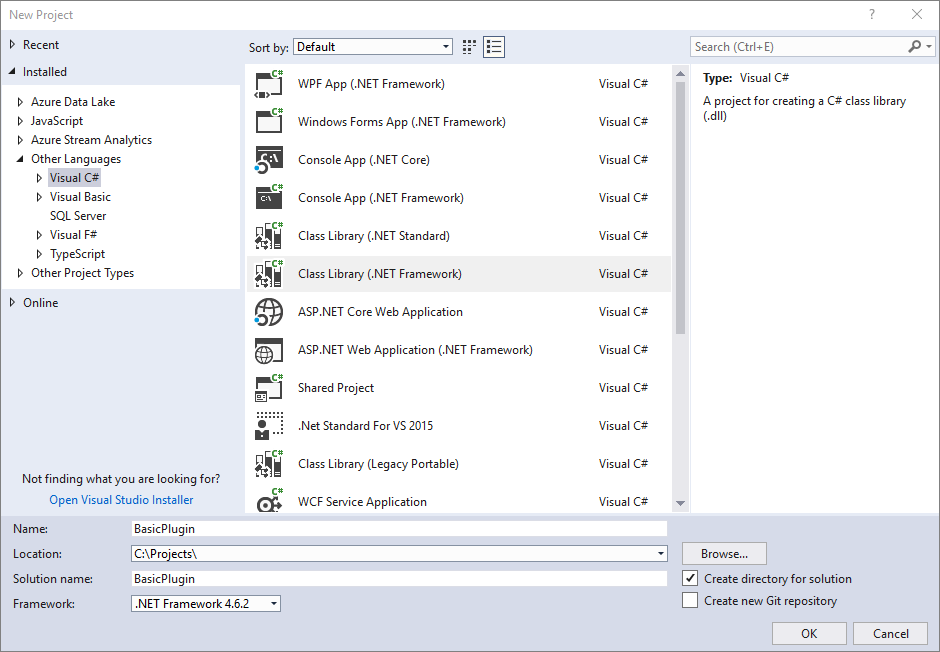
The name used for the project will be the name of the assembly. This tutorial uses the name
BasicPlugin. -
In Solution Explorer, right-click the project and select Manage NuGet Packages… from the context menu.
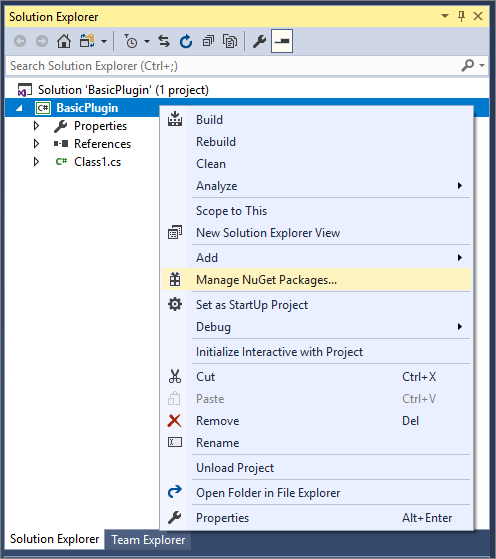
-
Select Browse and search for
Microsoft.CrmSdk.CoreAssembliesand install the latest version.
-
You must select I Accept in the License Acceptance dialog.
Note
Adding the
Microsoft.CrmSdk.CoreAssembliesNuGet package will include these assemblies in the build folder for your assembly, but you will not upload these assemblies with the assembly that includes your logic. These assemblies are already present in the sandbox runtime.Do not include any other NuGet packages or assemblies to the build folder of your project. You cannot include these assemblies when you register the assembly with your logic. You cannot assume that the assemblies other than those included in the
Microsoft.CrmSdk.CoreAssembliesNuGet package will be present and compatible with your code. -
In Solution Explorer, right-click the
Class1.csfile and choose Rename in the context menu.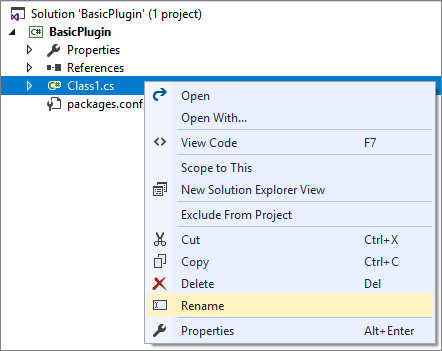
-
Rename the
Class1.csfile toFollowupPlugin.cs. -
When prompted, allow Visual Studio to re-name the class to match the file name.
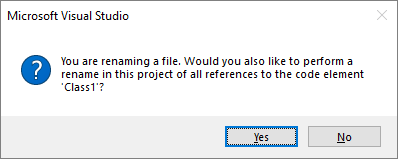
Edit the Class file to enable a plug-in
-
Add the following
usingstatements to the top of theFollowupPlugin.csfile:C#using System.ServiceModel; using Microsoft.Xrm.Sdk; -
Implement the IPlugin Interface by editing the class.
Note
If you just type
: IPluginafter the class name, Visual Studio will auto-suggest implementing a stub for the Execute Method.C#public class FollowupPlugin : IPlugin { public void Execute(IServiceProvider serviceProvider) { throw new NotImplementedException(); } } -
Replace the contents of the
Executemethod with the following code:
// Obtain the tracing service
ITracingService tracingService =
(ITracingService)serviceProvider.GetService(typeof(ITracingService));
// Obtain the execution context from the service provider.
IPluginExecutionContext context = (IPluginExecutionContext)
serviceProvider.GetService(typeof(IPluginExecutionContext));
// The InputParameters collection contains all the data passed in the message request.
if (context.InputParameters.Contains("Target") &&
context.InputParameters["Target"] is Entity)
{
// Obtain the target entity from the input parameters.
Entity entity = (Entity)context.InputParameters["Target"];
// Obtain the organization service reference which you will need for
// web service calls.
IOrganizationServiceFactory serviceFactory =
(IOrganizationServiceFactory)serviceProvider.GetService(typeof(IOrganizationServiceFactory));
IOrganizationService service = serviceFactory.CreateOrganizationService(context.UserId);
try
{
// Plug-in business logic goes here.
}
catch (FaultException<OrganizationServiceFault> ex)
{
throw new InvalidPluginExecutionException("An error occurred in FollowUpPlugin.", ex);
}
catch (Exception ex)
{
tracingService.Trace("FollowUpPlugin: {0}", ex.ToString());
throw;
}
}
About the code
- The ITracingService enables writing to the tracing log. You can see an example in the final catch block. More information: Use Tracing
- The IPluginExecutionContext provides access to the context for the event that executed the plugin. More information: Understand the execution context.
- The code verifies that the context InputParameters includes the expected parameters for the CreateRequest that this plug-in will be registered for. If the Target property is present, the Entity that was passed to the request will be available.
- The IOrganizationServiceFactory interface provides access to a service variable that implements the IOrganizationService interface which provides the methods you will use to interact with the service to create the task.
Add business logic
The plug-in will create a task activity that will remind the creator of the account to follow up one week later.
Add the following code to the try block. Replace the comment: // Plug-in business logic goes here. with the following:
// Create a task activity to follow up with the account customer in 7 days.
Entity followup = new Entity("task");
followup["subject"] = "Send e-mail to the new customer.";
followup["description"] =
"Follow up with the customer. Check if there are any new issues that need resolution.";
followup["scheduledstart"] = DateTime.Now.AddDays(7);
followup["scheduledend"] = DateTime.Now.AddDays(7);
followup["category"] = context.PrimaryEntityName;
// Refer to the account in the task activity.
if (context.OutputParameters.Contains("id"))
{
Guid regardingobjectid = new Guid(context.OutputParameters["id"].ToString());
string regardingobjectidType = "account";
followup["regardingobjectid"] =
new EntityReference(regardingobjectidType, regardingobjectid);
}
// Create the task in Microsoft Dynamics CRM.
tracingService.Trace("FollowupPlugin: Creating the task activity.");
service.Create(followup);
About the code
- This code uses the late-bound style to create a task and associate it with the account being created. More information: Create entities using the Organization Service
- Early bound classes can be used, but this requires generating the classes for the entities and including the file defining those classes with the assembly project. This is mostly a personal preference, so those steps have been left out of this tutorial for brevity. More information: Late-bound and Early-bound programming using the Organization service
- The Id of the account being created is found in the context OutputParameters and set as the
regardingobjectidlookup attribute for the task.
Build plug-in
In Visual Studio, press F6 to build the assembly. Verify that it compiles without error.
Sign plug-in
-
In Solution Explorer, right click the BasicPlugin project and in the context menu select Properties.

-
In the project properties, select the Signing tab and select the Sign the assembly checkbox.
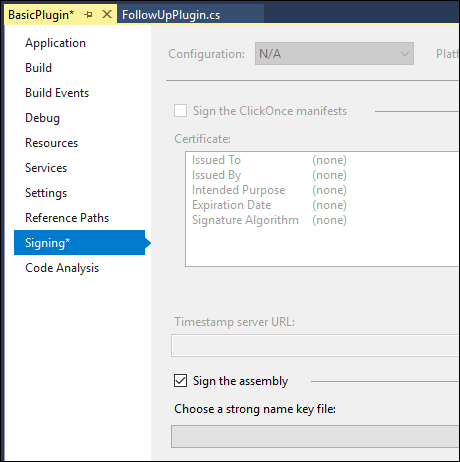
-
In the Choose a strong name key file: dropdown, select <New…>.
-
In the Create Strong Name Keydialog, enter a key file name and deselect the Protect my key file with a password checkbox.
-
Click OK to close the Create Strong Name Key dialog.
-
In the project properties Build tab, verify that the Configuration is set to Debug.
-
Press F6 to build the plug-in again.
-
Using windows explorer, find the built plug-in at:
\bin\Debug\BasicPlugin.dll.
Note
Build the assembly using Debug configuration because you will use the Plug-in profiler to debug it in a later tutorial. Before you include a plug-in with your solution, you should build it using the release configuration.
Register plug-in
To register a plug-in, you will need the plug-in registration tool
Connect using the Plug-in Registration tool
-
After you have downloaded the Plug-in registration tool, click the
PluginRegistration.exeto open it. -
Click Create new Connection to connect to your instance.
-
Make sure Office 365 is selected. If you are connecting using a Microsoft account other than one you are currently using, click Show Advanced.
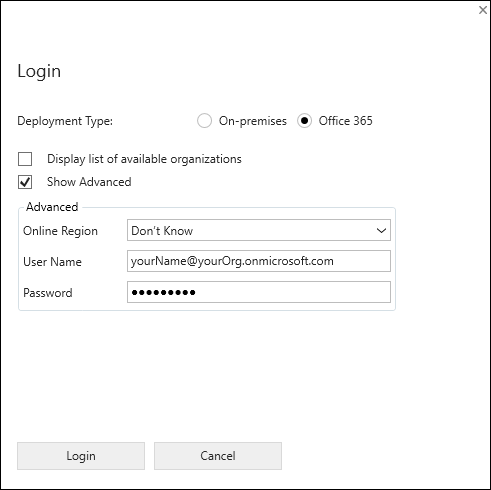
-
Enter your credentials and click Login.
-
If your Microsoft Account provides access to multiple environments, you will need to choose an environment.
-
After you are connected, you will see any existing registered plug-ins & custom workflow activities
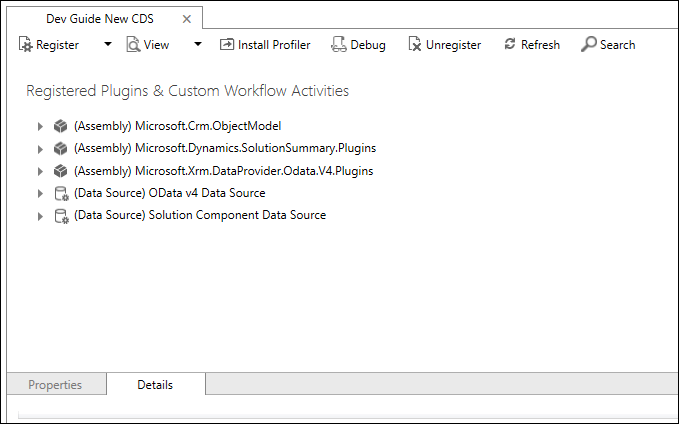
Register your assembly
-
In the Register drop-down, select New Assembly.
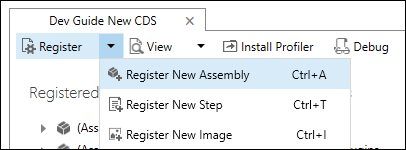
-
In the Register New Assembly dialog, select the ellipses (…) button and browse to the assembly you built in the previous step.
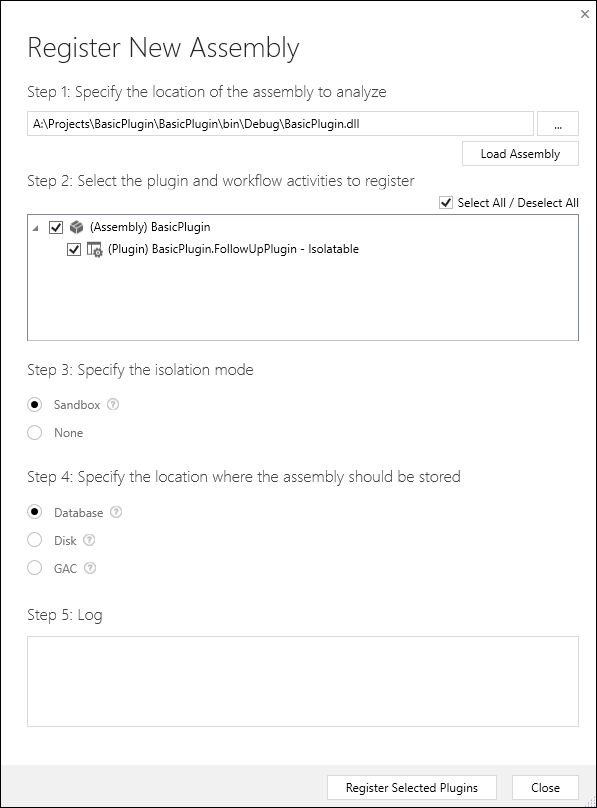
-
For Microsoft 365 users, verify that the isolation mode is sandbox and the location to store the assembly is Database.
Note
Other options for isolation mode and location apply to on-premises Dynamics 365 deployments. For the location, you can specify the D365 server's database, the server's local storage (disk), or the server's Global Assembly Cache. For more information see Plug-in Storage.
-
Click Register Selected Plug-ins.
-
You will see a Registered Plug-ins confirmation dialog.
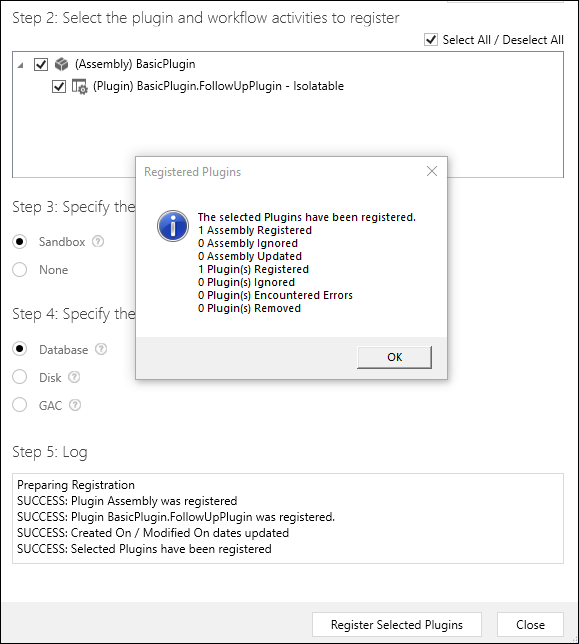
-
Click OK to close the dialog and close the Register New Assembly dialog.
-
You should now see the (Assembly) BasicPlugin assembly which you can expand to view the (Plugin) BasicPlugin.FollowUpPlugin plugin.

Register a new step
-
Right-click the (Plugin) BasicPlugin.FollowUpPlugin and select Register New Step.
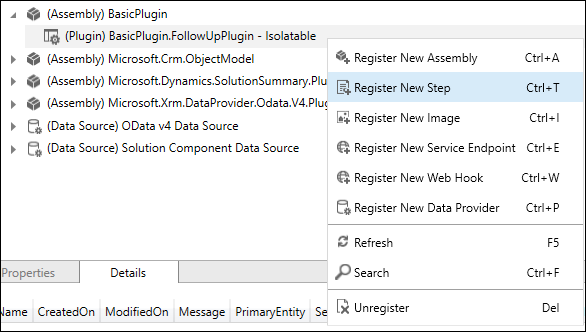
-
In the Register New Step dialog, set the following fields:
Setting Value Message Create Primary Entity account Event Pipeline Stage of Execution PostOperation Execution Mode Asynchronous 
-
Click Register New Step to complete the registration and close the Register New Step dialog.
-
You can now see the registered step.

Note
At this point the assembly and steps are part of the system Default Solution. This is a good time to add them to the unmanaged solution you will distribute. These steps are not included in this tutorial. See Add your assembly to a solution and Add step to solution for more information.
Test plug-in
-
Open a model-driven app and create an account entity.
-
Within a short time, open the account and you can verify the creation of the task.
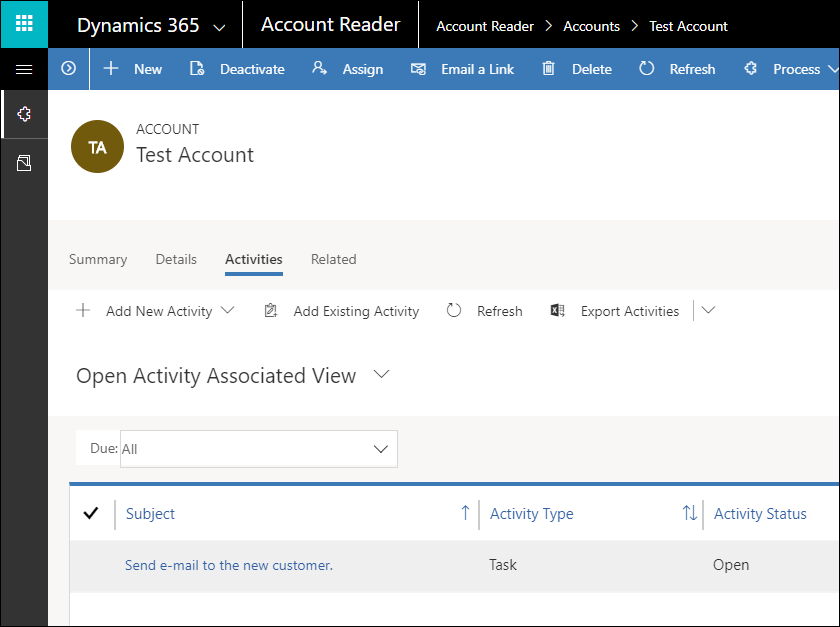
What if the task wasn't created?
Because this is an asynchronous plug-in, the operation to create the task occurs after the account is created. Usually, this will happen immediately, but if it doesn't you may still be able to view the system job in the queue waiting to be applied. This step registration used the Delete AsyncOperation if StatusCode = Successful option which is a best practice. This means as soon as the system job completes successfully, you will not be able to view the system job data unless you re-register the plug-in with the Delete AsyncOperation if StatusCode = Successful option unselected.
However, if there was an error, you can view the system job to see the error message.
View System jobs
Use the Dynamics 365 --custom app to view system jobs.
-
In your model-driven app, navigate to the
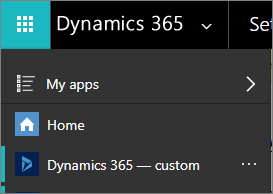
-
In the Dynamics 365 --custom app, navigate to Settings > System > System Jobs.

-
When viewing system jobs, you can filter by Entity. Select Account.

-
If the job failed, you should see a record with the name BasicPlugin.FollowupPlugin: Create of account

-
If you open the system job, you can expand the Details section to view the information written to the trace and details about the error.
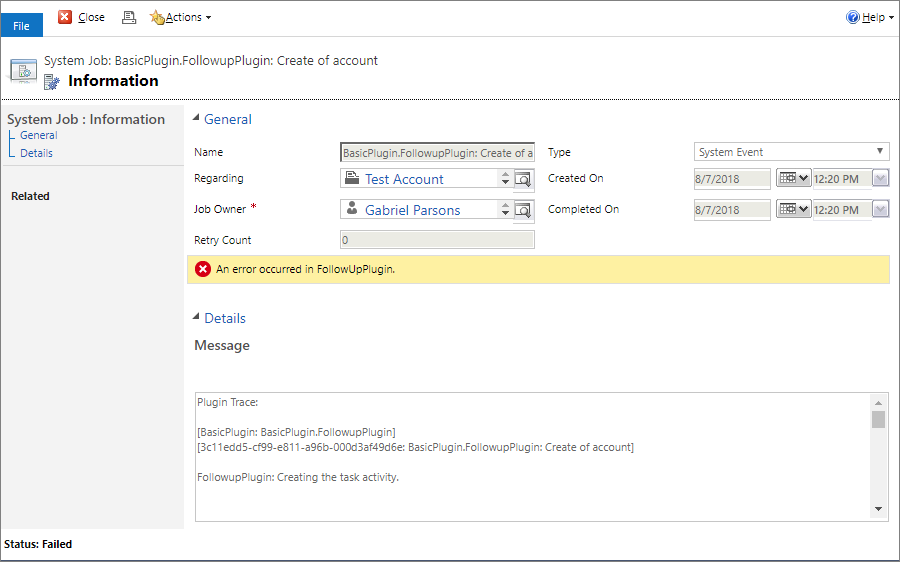
Query System jobs
You can use the following Web API query to return failed system jobs for asynchronous plug-ins
GET <your org uri>/api/data/v9.0/asyncoperations?$filter=operationtype eq 1 and statuscode eq 31&$select=name,message
More information: Query Data using the Web API
Or use the following FetchXml:
<fetch top='50' >
<entity name='asyncoperation' >
<attribute name='message' />
<attribute name='name' />
<filter type='and' >
<condition attribute='operationtype' operator='eq' value='1' />
<condition attribute='statuscode' operator='eq' value='31' />
</filter>
</entity>
</fetch>
More information: Use FetchXML with FetchExpression
View trace logs
The sample code wrote a message to the trace log. The steps below describe how to view the logs.
By default, plug-in trace logs are not enabled.
Tip
IF you prefer to change this setting in code: This setting is in the Organization Entity PluginTraceLogSetting attribute.
The valid values are:
| Value | Label |
|---|---|
| 0 | Off |
| 1 | Exception |
| 2 | All |
Use the following steps to enable them in a model-driven app.
-
Open the Dynamics 365 - custom app.
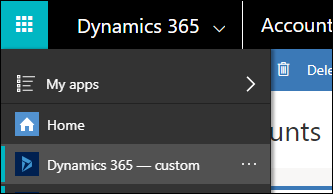
-
Navigate to Settings > System > Administration.

-
In Administration, select System Settings.
-
In the System Settings dialog, in the customization tab, set Enable logging to plug-in trace log to All.
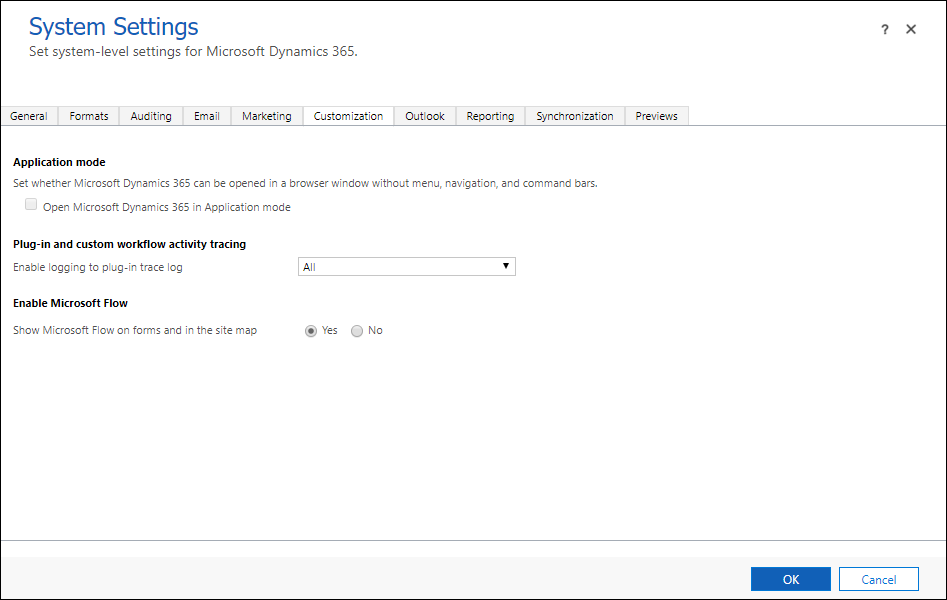
Note
You should disable logging after you are finished testing your plug-in, or at least set it to Exception rather than All.
-
Click OK to close the System Settings dialog.
-
Repeat the steps to test your plug-in by creating a new account.
-
In the Dynamics 365 -- custom app, navigate to Settings > Customization > Plug-In Trace Log.
-
You should find that a new Plug-in Trace Log record has been created.

-
If you open the record you might expect that it would include the information you set in your trace, but it does not. It only verifies that the trace occurred.
-
To see the details, it is easier to query this data using the Web API in your browser using the following query with the plugintracelog EntityType, using the
typenameproperty to filter results in themessageblockproperty based on the name of the plug-in class:GET <your org uri>/api/data/v9.0/plugintracelogs?$select=messageblock&$filter=typename eq 'BasicPlugin.FollowUpPlugin' -
You can expect to see the following returned with the Web API query:
JSON{ "@odata.context": "<your org uri>/api/data/v9.0/$metadata#plugintracelogs(messageblock)", "value": [{ "messageblock": "FollowupPlugin: Creating the task activity.", "plugintracelogid": "f0c221d1-7f84-4f89-acdb-bbf8f7ce9f6c" }] }
posted on 2020-11-17 11:53 lingdanglfw 阅读(90) 评论(0) 编辑 收藏 举报





【推荐】国内首个AI IDE,深度理解中文开发场景,立即下载体验Trae
【推荐】编程新体验,更懂你的AI,立即体验豆包MarsCode编程助手
【推荐】抖音旗下AI助手豆包,你的智能百科全书,全免费不限次数
【推荐】轻量又高性能的 SSH 工具 IShell:AI 加持,快人一步
· Linux系列:如何用 C#调用 C方法造成内存泄露
· AI与.NET技术实操系列(二):开始使用ML.NET
· 记一次.NET内存居高不下排查解决与启示
· 探究高空视频全景AR技术的实现原理
· 理解Rust引用及其生命周期标识(上)
· DeepSeek 开源周回顾「GitHub 热点速览」
· 物流快递公司核心技术能力-地址解析分单基础技术分享
· .NET 10首个预览版发布:重大改进与新特性概览!
· AI与.NET技术实操系列(二):开始使用ML.NET
· 单线程的Redis速度为什么快?
2008-11-17 lookup (relation)